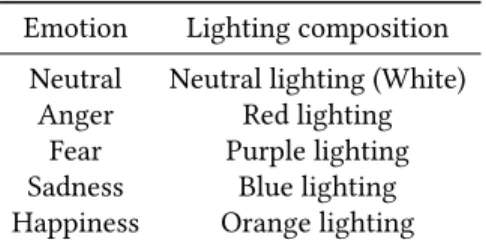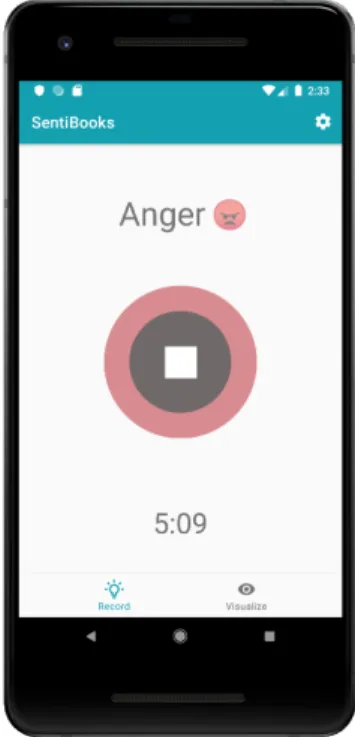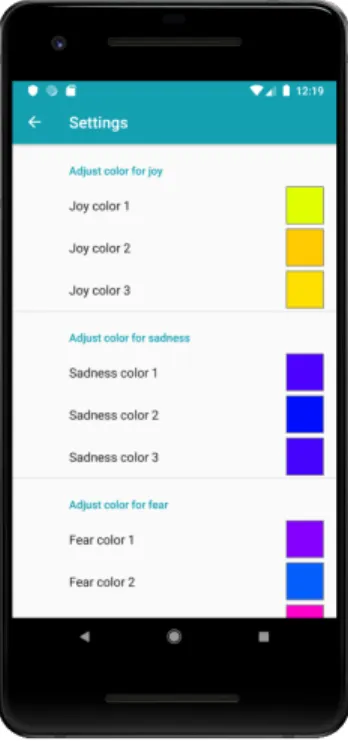SentiBooks: Enhancing Audiobooks via Affective Computing and Smart Light Bulbs
Anna-Marie Ortloff anna-marie.ortloff@
student.ur.de Media Informatics Group University of Regensburg Regensburg, Germany
Lydia Güntner lydia-maria.guentner@
student.ur.de Media Informatics Group University of Regensburg Regensburg, Germany
Maximiliane Windl maximiliane.windl@
student.ur.de Media Informatics Group University of Regensburg Regensburg, Germany Thomas Schmidt
thomas.schmidt@ur.de Media Informatics Group University of Regensburg Regensburg, Germany
Martin Kocur martin.kocur@ur.de Media Informatics Group University of Regensburg Regensburg, Germany
Christian Wolff christian.wolff@ur.de Media Informatics Group University of Regensburg Regensburg, Germany ABSTRACT
We present SentiBooks, a smartphone application to enhance the audiobook listening experience via affective computing and smart light bulbs. Users can connect to Philips Hue Light Bulbs with a smartphone app while listening to an audiobook.
The app analyzes the emotional expression of the narrator of the audiobook using speech emotion recognition and adjusts the colors of the lighting settings according to the expression of the narrator in 10-seconds intervals. By transitioning be- tween colors that are connected to the specific emotion that is currently dominant in the reading, the overall audiobook experience is intensified.
CCS CONCEPTS
• Human-centered computing → Visualization; Inter- action paradigms; Ubiquitous and mobile computing; • Com- puting methodologies → Machine learning.
KEYWORDS
affective computing, smart light bulbs, lighting, emotion detection, sentiment analysis
ACM Reference Format:
Anna-Marie Ortloff, Lydia Güntner, Maximiliane Windl, Thomas Schmidt, Martin Kocur, and Christian Wolff. 2019. SentiBooks: En- hancing Audiobooks via Affective Computing and Smart Light Permission to make digital or hard copies of part or all of this work for personal or classroom use is granted without fee provided that copies are not made or distributed for profit or commercial advantage and that copies bear this notice and the full citation on the first page. Copyrights for third- party components of this work must be honored. For all other uses, contact the owner/author(s).
MuC ’19, September 8–11, 2019, Hamburg, Germany
© 2019 Copyright held by the owner/author(s).
ACM ISBN 978-1-4503-7198-8/19/09.
https://doi.org/10.1145/3340764.3345368
Bulbs. In Mensch und Computer 2019 (MuC ’19), September 8–11, 2019, Hamburg, Germany. ACM, New York, NY, USA, 4 pages.
https://doi.org/10.1145/3340764.3345368
1 INTRODUCTION
Audiobooks are a popular form of entertainment as recent numbers on the rapid revenue growth of downloadable au- diobooks in the U.S. show [1]. Have and Pederson refer to the popularity of smartphones and online streaming services like Spotify and Audible to explain the growing expansion of the user group [6]. Indeed, the flexibility of these tech- nologies led many users to listen to audiobooks in the car or while performing mundane tasks. Current surveys show that the vast majority of users listens to audiobooks at home [2]. In the following demonstration paper, we present our first explorations on how to enhance the audiobook listening experience in this specific home context. We present a novel approach to combine affective computing and the surround- ing lighting system to create an illumination that is in line with the emotional expression of the current passage of the audiobook.
The illumination and lighting systems in our house are an important part of our everyday living. Research showed that illumination has an influence on our behavior and activities [18], our state of relaxation [10] and our attention [10]. With the rise of smart home technology, many everyday objects, in- cluding lighting systems and light bulbs also became “smart”
and connected to the Internet. Users of smart light bulbs are able to change lighting settings and colors easily via smart- phone apps. However, there are also applications allowing automatic adjustments of lighting depending on external factors such as the movement of the users [16] or the time of the day [12]. One of the few successful applications integrat- ing colorful indoor lighting in everyday life are Ambilight Demos
863
MuC ’19, September 8–11, 2019, Hamburg, Germany Ortloff et al.
Smart TV s. Ambilight Smart TV s possess multiple smaller LED-bulbs at the rear part of the TV that glow in the color of the TV image depending on the position of the LED bulb on the TV. This type of TV enhancement indeed improves the overall viewing experience [3]. Jones et al. build upon this idea and explored different ways to use the surrounding light- ning of the TV for projected illusions in the context of video games to improve the game experience [9]. While it is rather simple to refer to the colors of a TV image for enhancement, it is unclear how to decide upon the most fitting illumination colors in the context of audiobooks since there is no clear visual channel to derive the color from. We propose to use the emotional expression of the narrator of the audiobook to define the lighting composition and enhance the hearing experience since emotions and sentiments are substantial parts in the reception of narrative literature. Furthermore, by relying on research about which colors evoke specific emotions in humans [13, 20, 21], we hypothesize that by presenting colored light in line with the current emotion of the narration, similar emotions are invoked in the listener, thus intensifying their experience. There are a lot of exciting developments considering the usage of novel technologies like augmented reality or tangible interfaces to enhance the reading experience of traditional books [14]. In a similar way our approach employs novel technologies to improve the experience of audiobooks.
To extract emotions we employ methods from the applica- tion area of affective computing. Affective computing deals with the recognition and simulation of human emotions [19].
Due to advances in the context of machine learning and neu- ral networks, state-of-the-art systems that predict human emotion and sentiments perform rather well with accuracies around 90% [19]. The most accurate and successful results can be found for the research areas of the prediction of sen- timents and emotions in written text (also often called Senti- ment Analysis [11]) and facial emotion recognition [7]. Nev- ertheless, there are also various systems for the prediction of emotion from human speech, implementing machine learn- ing on corpora of human voice snippets and their emotional expression. There are various voice related features used for machine learning. Some examples are the pitch, pitch dy- namics or the loudness. An overview about approaches and tools can be found in [5]. Although speech emotion analysis is currently outperformed by other modalities, speech-based systems still achieve accuracies of up to 80% [5] and have the advantage to be rather language independent. Since those systems are mostly evaluated with corpora representing ev- eryday language and speakers, we assume that the general accuracy for our use case might be higher since narrators of audiobooks tend to put more emotion in their pronunciation for narrative and effect-specific purposes. At the same time, they typically are actors or professionally trained speakers
Table 1: Default colors for emotions Emotion Lighting composition
Neutral Neutral lighting (White)
Anger Red lighting
Fear Purple lighting Sadness Blue lighting Happiness Orange lighting
for which speech-based recognition algorithms should work well.
Considering the connection between the emotional ex- pression and the colors of the lighting composition, there is no established research about which illumination colors are related with specific emotions and feelings. Therefore, we will refer to basic research from the context of color psychology [13, 21] and design recommendations [20] to decide upon which type of emotion is represented by which color by default. However, we also enable users to adjust emotion-color connections (see section 3).
2 THE SENTIBOOKS APPLICATION
The main parts of our system are (1) the Philips Hue Light Bulbs, (2) the Vokaturi Speech Emotion Recognition Tool and (3) an Android smartphone app. We name our application SentiBooks as a compound of the words sentiment and book.
Philips Hue Light Bulbs
The Philips Hue Light Bulbs
1are a smart light bulbs sys- tem consisting of multiple bulbs and a bridge connecting the bulbs to WiFi. Via a system API, developers can create application and address the lights to change the saturation, brightness, overall color of the bulbs and call upon a limited range of effects like a “flash” or “color loop”. The colors of these light bulbs are based on the CIE color space and support a specific limited range of colors. Note that there are specific colors that cannot be represented by the bulbs (e.g. black) or that differ slightly from the general understanding of a color (e.g. green). The default setup of the Philips Hue sys- tem consist of three light bulbs. Based on color psychology [13, 21] and design recommendations (e.g.[20]) we defined five light compositions for the three lamps to represent spe- cific emotions we analyze via speech emotion recognition.
Table 1 summarizes the emotions and the dominant color for the respective lighting setting. Note, that these are only our proposed default settings. We also offer the functionality to change and adapt the color-emotion connection as the users sees fit via the smartphone app.
1
https://www2.meethue.com/en-us/bulbs
Demos
864
SentiBooks MuC ’19, September 8–11, 2019, Hamburg, Germany Speech Emotion Recognition
To identify the emotional expression of the narrator we use Vokaturi. Vokaturi
2is a tool for speech emotion recognition offering libraries for various platforms. We use the free ver- sion OpenVokaturi, which is considered the best free speech emotion recognition software on the market [5]. Given the audio of spoken language, Vokaturi calculates values for the four emotions anger, fear, sadness and happiness and for a neutral emotional value of the speech. Vokaturi uses two audio databases consisting of recordings of actors speaking sentences with different intended emotions [4, 8]. Vokaturi uses this databases as training data for machine learning with various acoustic features like the pitch, the intensity and the spectral slope. The emotional values Vokaturi pro- duces range between 0 and 1 and sum up to one. We calculate the emotion of the audiobook in 10-seconds intervals by se- lecting the emotion that is reported with the highest value by Vokaturi for a specific interval.
Smartphone Application
We have developed a smartphone app for Android to perform the communication between the light bulbs and the emotion recognition as well as for the overall interaction with the lamps. After connecting with the Philips Hue Light Bulbs, users can start a “recording” similar to a default audio player.
Users can choose to use an external audio stream, e.g. by starting an audiobook on the smartphone or on an audio player, or use a saved audiobook on the smartphone and listen to it via headphones. Every 10 seconds the app tries to identify the most dominant emotion of the narration and thus adjusts the color setting of the bulbs. The name of the most dominant emotion is also shown on the screen of the app (see figure 1).
Although emotions might change more frequent we chose 10-seconds intervals since shorter intervals proved too fast and hectic while 10-seconds intervals lead to rather smooth transitions. However, in future evaluations we want to ana- lyze which intervals work best for the user. Users can also save the bulb instructions of the recording and visualize the color progression of an audiobook thus allowing the analysis and comparison of the emotional development in audiobooks (see figure 2).
As mentioned, the research about color-emotion connec- tions is not fully clear and dependent of the individual inter- pretation of the user [13]. Therefore, via the settings options of the smartphone app users can adjust the color-emotion connection, as they prefer (see figure 3).
2


